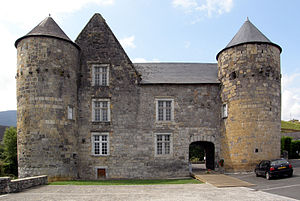Aussurucq
|
Aussurucq Altzürükü |
||
|---|---|---|
|
|
||
| region | Nouvelle-Aquitaine | |
| Department | Pyrénées-Atlantiques | |
| Arrondissement | Oloron-Sainte-Marie | |
| Canton | Montagne Basque | |
| Community association | Pays Basque | |
| Coordinates | 43 ° 9 ′ N , 0 ° 56 ′ W | |
| height | 191-1,284 m | |
| surface | 47.12 km 2 | |
| Residents | 245 (January 1, 2017) | |
| Population density | 5 inhabitants / km 2 | |
| Post Code | 64130 | |
| INSEE code | 64081 | |
 Aussurucq - Church with clocher trinitaire |
||
Aussurucq ( Basque Altzürükü ) is a commune in the French part of the Basque country with 245 inhabitants (at January 1, 2017) in the department of Pyrénées-Atlantiques in the region Nouvelle-Aquitaine . It belongs to the arrondissement of Oloron-Sainte-Marie and the canton of Montagne Basque (until 2015: canton of Mauléon-Licharre ).
location
Aussurucq lies at the foot of the Massif des Arbailles (highest peak 1286 m) and is only about 10 km northeast of Mauléon-Licharre .
Population development
| year | 1800 | 1851 | 1901 | 1954 | 1999 | 2014 |
| Residents | 574 | 716 | 523 | 401 | 254 | 250 |
The continuous decline in the number of inhabitants over the last 200 years is primarily due to the loss of jobs as a result of the increasing mechanization of agriculture .
economy
The small mountain village of Aussurucq is still very agriculturally oriented. The Basque cheese Ossau-Iraty , a semi-hard cheese made from sheep's milk , is made here. Field management is not practiced.
history
Several prehistoric finds have been made in the area of the municipality; the most important are the remains of the two dolmens d'Ithe . Aussurucq belonged to the former Basque province of Soule .
Attractions
- The church of Aussurucq is located - slightly elevated - in the center and with its clocher trinitaire and its vestibule is one of the typical regional buildings in the Pays de Soule . Inside, it has only one nave and a wooden ceiling. A curiosity of the building is the clock attached to the sloping roof. A few Basque grave stelae ( hilarri ) can still be found in the surrounding cemetery .
- The building history of the Château de Ruthie goes back to the 11th century. The parts visible today date from the 15th (round towers) and 16th centuries (central part); behind it are further additions from the 19th century. Pierre de Charritte de Ruthie, the confessor of Francis I , came from here . The building, recognized as a monument historique since 1925, is now used for community purposes.
literature
- Jean-Marie Régnier: Histoire de la Soule. Volume 1: Des Origines à la Révolution. Ekaina et al., St.-Jean-de-Luz et al. 1991, ISBN 2-908132-05-2 .
Web links
Individual evidence
- ↑ Aussurucq - Château de Ruthie
- ↑ Château de Ruthie in the Base Mérimée of the French Ministry of Culture (French)

